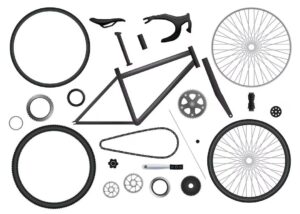A fibra de carbono é um peso leve, forte, e material durável feito de fios finos de átomos de carbono. É conhecido por sua alta resistência à tração e baixo peso, tornando -o um material ideal para a construção da estrutura de bicicleta. As propriedades da fibra de carbono permitem a criação de quadros rígidos e responsivos que fornecem excelentes características de transferência de energia e manuseio. Neste artigo, Vamos explorar os diferentes tipos de fibra de carbono usados em quadros de bicicleta, suas características, benefícios, e fatores a serem considerados ao escolher o certo para suas necessidades de ciclismo.

Fibra de carbono de alto módulo
A fibra de carbono de alto módulo é o tipo mais rígido e mais forte de fibra de carbono disponível. É composto de fibras de carbono bem compactadas, resultando em um material com excelente rigidez e flexão mínima. O termo “alto módulo” refere -se ao alto nível de rigidez exibido por esse tipo de fibra de carbono, o que permite transmitir energia e responder rapidamente à entrada do piloto com eficiência. Esse tipo de fibra de carbono é comumente usado em bicicletas de alta eficiência e montanha, onde a rigidez e a capacidade de resposta são cruciais.
Características
Fibra de carbono de alto módulo, conhecido como fibra de carbono Ultra-High-Modulus, é projetado para oferecer rigidez e força excepcionais, mantendo um perfil leve. Possui uma baixa proporção de peso / resistência e alta resistência às forças de flexão e torção. Oferece excelente transferência de energia durante o pedal e garante a potência máxima e minimizando as vibrações flexíveis e as vibrações.
Benefícios da construção da estrutura da bicicleta
A fibra de carbono de alto módulo nos quadros de bicicleta aumenta a rigidez e a capacidade de resposta, Tornando o quadro mais eficiente na transferência do poder do piloto para as rodas. Esse tipo de fibra de carbono aprimora o desempenho geral da bicicleta, fornecendo recursos de escalada superiores e melhor manuseio em alta velocidade. Além do mais, Os quadros feitos com esse tipo de fibra de carbono exibem perda mínima de energia durante a pedal, permitindo que os ciclistas atinjam a máxima eficiência e velocidade. Seu desempenho na precisão das curvas e manuseio geral o torna ideal para corridas competitivas e pilotagem orientada para o desempenho.
Fibra de carbono intermediário-módulo
A fibra de carbono intermediário-módulo é um tipo de material composto reconhecido por seu equilíbrio entre rigidez e conformidade. Oferece um nível moderado de rigidez enquanto ainda fornece algum grau de amortecimento de vibração, resultando em uma experiência de pilotagem confortável e responsiva. Esse tipo de fibra de carbono é comumente encontrado em resistência e bicicletas de estrada em geral, onde o conforto e o desempenho são igualmente importantes.
Características
A fibra de carbono intermediário-modulus é conhecida por sua proporção moderada de peso / resistência e sua capacidade de amortecer as vibrações na estrada. Ele fornece uma qualidade de condução suave e confortável, mantendo rigidez suficiente para transferência de energia eficiente.
Aplicações em quadros de bicicleta
A fibra de carbono intermediário-módulo é comumente usada em quadros de bicicleta focada em resistência projetados para pilotagem de longa distância e terreno acidentado. Por exemplo, um dos quadros de carbono que quinze chins premium TP-140018. Sua capacidade de absorver vibrações nas estradas aumenta o conforto durante passeios prolongados, reduzindo a fadiga e melhorando a qualidade do passeio. Adicionalmente, Os quadros construídos com fibra de carbono intermediário-módulo oferece uma mistura de eficiência e conforto, tornando -os adequados para uma ampla gama de disciplinas de ciclismo.
Fibra de carbono padrão-modulus
A fibra de carbono padrão-módulo é feita de poliacrilonitrila (FRIGIDEIRA) Fibras precursoras, que são carbonizados em altas temperaturas para criar fibras de carbono puras. Oferece boa rigidez, permanecendo relativamente acessível em comparação com variantes de alto módulo. Devido à sua acessibilidade, Tornou -se a escolha popular para muitos fabricantes de quadros de bicicleta.
A fibra de carbono padrão-modulus é comumente empregada em vários estilos de estrutura de bicicleta, De bicicletas de estrada de nível básico a bicicletas de montanha de ponta. Fornece excelente transferência de energia e capacidade de resposta, Tornando-o adequado para ciclistas recreativos e entusiastas que buscam quadros orientados para o desempenho sem o preço premium.
Características
A fibra de carbono padrão-modulus é caracterizada por sua facilidade de produção e acessibilidade. Ele fornece rigidez adequada para a maioria dos pilotos, sendo mais perdoadora em termos de qualidade de condução em comparação com a fibra de carbono de alto-módulo.
Usos comuns na fabricação de quadros de bicicleta
A fibra de carbono padrão-módulo é amplamente utilizada em bicicletas de estrada básica, Bicicletas de viagem, e bicicletas de montanha recreativas. Embora não tão rígido quanto a fibra de carbono de alto módulo, A fibra de carbono padrão-modulus ainda oferece excelente transferência de energia e capacidade de resposta. Ele fornece uma boa mistura de desempenho e acessibilidade para os ciclistas que procuram um quadro leve e durável sem gastar muito.
Benefícios de diferentes tipos de fibra de carbono em quadros de bicicleta

Cada tipo de fibra de carbono usada em quadros de bicicleta oferece vantagens únicas adaptadas a diferentes preferências de pilotagem e objetivos de desempenho. Vamos explorar os benefícios do alto módulo, módulo intermediário, e fibra de carbono padrão-modulus na construção da estrutura da bicicleta.
Aumento da rigidez para escalar
A fibra de carbono de alto módulo aumenta a rigidez e a rigidez nos quadros de bicicleta, tornando -os mais responsivos durante os esforços de escalada. O aumento da transferência de energia e a eficiência de pedalamento permitem aos pilotos enfrentar inclinações acentuadas com maior facilidade e velocidade.
Absorção de choque aprimorada
A fibra de carbono intermediário-modulus oferece propriedades de absorção de choques e amortecimento de vibração aprimorados, resultando em um passeio mais suave e confortável. Esse tipo de fibra de carbono ajuda.
Aerodinâmica melhorada
A fibra de carbono padrão-módulo fornece boas propriedades aerodinâmicas que ajudam a reduzir a resistência ao vento e melhorar a velocidade geral. O design simplificado de quadros de bicicleta fabricados com fibra de carbono padrão-módulo permite fluxo de ar eficiente e desempenho aprimorado em eventos de ciclismo competitivo.
Fatores a serem considerados ao escolher fibra de carbono para quadros de bicicleta
Ao adquirir quadros de bicicleta de fibra de carbono dos melhores fabricantes de quadros de carbono chineses como BRILHE LOGO, Vários fatores entram em jogo para garantir a experiência ideal de pilotagem. Compreendendo essas considerações importantes, como peso, rigidez, e força, é essencial para tomar uma decisão informada.
Peso
A fibra de carbono de alto módulo é a opção mais leve, ideal para os pilotos que priorizam o desempenho e a aceleração de escalada, mas podem ter um custo mais alto, Enquanto a fibra de carbono padrão-modulus oferece um bom equilíbrio entre peso e acessibilidade. No entanto, É essencial encontrar um equilíbrio entre peso e durabilidade, Como os quadros excessivamente leves podem sacrificar força e longevidade.
Rigidez
A rigidez de uma estrutura de fibra de carbono afeta diretamente as características de transferência de energia e manuseio. Os quadros de fibra de carbono de alto-módulo oferecem o mais alto nível de rigidez, fornecendo uma experiência de condução responsiva e eficiente. No entanto, pilotos que preferem um mais suave, Passeio mais compatível pode optar por quadros construídos com fibra de carbono intermediário-módulo ou padrão-módulo.
Força
Enquanto todos os tipos de fibra de carbono oferecem taxas de força / peso excepcionais, A fibra de carbono de alto módulo geralmente fornece o mais alto nível de resistência de força e impacto. Os pilotos que se envolvem em estilos agressivos de pilotagem ou participam de corridas competitivas podem se beneficiar da durabilidade adicional de quadros de fibra de carbono de alto módulo. Embora a fibra de carbono intermediária e padrão-módulo ofereça força suficiente para a maioria das necessidades de ciclismo recreativas e competitivas.
Conclusão
Para concluir, A escolha da fibra de carbono afeta profundamente o desempenho e os atributos de quadros de bicicleta. Se o objetivo de aumentar a rigidez para subidas, Absorção de choque superior para conforto duradouro, ou aerodinâmica aprimorada para correr, Os vários tipos de fibra de carbono usados nos quadros de bicicleta atendem a diversos requisitos. Avaliando fatores como peso, rigidez, e força, Os ciclistas podem identificar a estrutura ideal de fibra de carbono para elevar sua experiência de pilotagem.

















